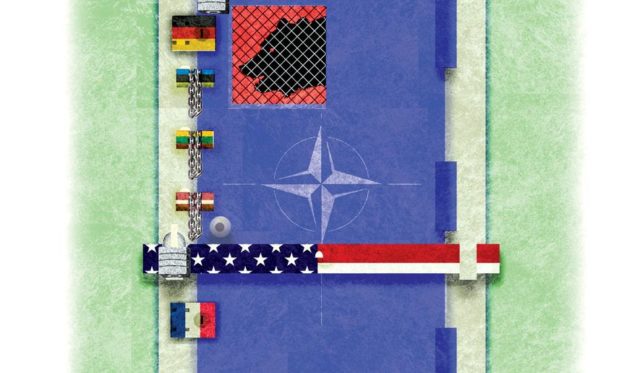Germany has been a thorn in Washington’s side on many issues from its failure to spend 2% of its very healthy GDP on its own military defense to its trade with Iran — including, some suspect, under-the-table nuclear goods trade — and the promotion of a U.S.-independent European Army.
For years it was on the wrong side on terrorism and terror-funding policy, only recently declaring Hezbollah a terrorist organization. And it is completely on the wrong side, from Washington’s point of view, on energy. The Germans are not only dependent on Russian natural gas supplies but are backing the newest pipeline to pump even more Russian gas into Germany and across Europe.
And so, when President Trump announced a planned reduction in American troop strength in Germany, it was seen as a knock on Germany and on NATO and a gift to Russia. Germany, maybe. NATO, no. And Russia won’t be pleased.
Washington has to be thinking about its obligations given the changed political and military circumstances under which NATO is operating in the 21st century. Despite the criticism of some former American military leaders, the reduction is no gift to the Russians.
In fact, it is a challenge to Russian President Vladimir Putin and his saber-rattling because Poland, not Germany, is on the firing line of any future land-based conflict. While some portion of the 9,500 soldiers planned to be removed from Germany will return to the United States, others will be redeployed around NATO states, particularly in Poland.
The collapse of the Soviet Union was not the end of Russia’s westward aspirations, but the strategic game in Europe has shifted over the past three decades. Under Cold War assumptions, the greatest danger and NATO’s highest priority was defending against a Soviet attack on Germany through a critical area known as the Fulda Gap.
This gap, made up of lowlands, is tank country, and if a fight broke out with Soviet and Warsaw Pact forces, the main armor thrust was expected through the gap, with the massing of forces starting in what was then East Germany. A less likely invasion route would have been across the North German plain, and there was reason to suppose that a parallel attack could have been launched through this corridor, with the 3rd Soviet Shock Corps leading any advance.
Most of the Warsaw Pact countries plus the Baltic States, freed of Soviet domination, have joined NATO, making the Fulda Gap no longer an available corridor. And an attack in the north would have to roll through Latvia, Lithuania and Estonia. The Baltic States are now a front line and most projections see defending them to be extremely difficult.
But if the Russians concentrated on this area in a conventional attack, Russia itself would potentially be in the crosshairs of a counterattack launched mainly from Poland. Poland, then, rather than Germany, is now the linchpin for defending Europe or, alternatively, for challenging Russia if Russian aggression turns away from Ukraine toward Central Europe.
Poland, which meets its NATO spending obligations for obvious reasons, needs more NATO support.
Germany is still the most powerful state in Europe with economic dominance and political influence over the common market and the EU. But Germany’s small, underfunded, and poorly maintained army and air force are no longer a front-line fighting force. It would take years of expansion and expenditure to change the picture. At the moment, Germany appears uninterested and the United States — and Poland — are moving in a different direction under the NATO umbrella.
Germany’s reaction to the potential changes are a “push-me pull-you.” On the one hand, as Germany’s asserts itself on the continent, it has not been at all shy about its desire to force America to back away from Europe and, by implication, from NATO. The idea of a European command and a European Army, championed by German Chancellor Angela Merkel and France’s unpopular President Emanuel Macron, is clear in its extreme bias against the United States.
Historically, France has been half in and half out of NATO, and while today it is more or less in, expecting France or Germany to come to the aid of Poland, or even the Baltic States, is open to question. Article 5 of the NATO Charter specifies that all the states need to agree even to consider using force before NATOcan act. One or two recalcitrant members can delay action indefinitely.
On the other hand, Germany’s Ms. Merkel has been vociferous in her denunciation of the planned American deployment from her country. Germany leads the vocal charge of opposition to Mr. Putin’s military activity in Ukraine and the annexation of Crimea. But Germany has mortgaged its energy future to Russia, and it should be noted that European sanctions on Russia over Ukraine are selective and don’t include energy supplies.
On the third hand, Germany’s status isn’t always what Germany wants it to be. A less-than-flattering joke making the rounds in Europe the past few years posits Ms. Merkel traveling to Athens. At the airport she meets with a Greek customs official. “Name?” “Angela Merkel,” she replies. “Occupation?” “No,” says Ms. Merkel, “Just visiting.”
History teaches us that wars happen when states don’t honor their obligations and responsibilities. Had the Nazis been opposed before Germany and the Soviet Union signed their “non-aggression pact,” Europe might have been spared a devastating war in which upwards of 50 million-60 million people, including millions of Jews and other minorities, died.
In this case, President Trump has given Germany — and other NATO allies — years of warning that their spending and rearmament had to reach the very minimal 2% level or there would be consequences.
And so there may be.






